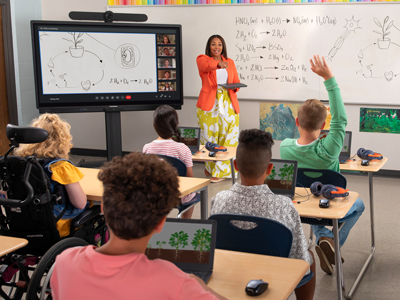Simple Tech Solutions for Inclusive Learning Environments
Watch the RecordingListen to the Podcast
One of the most important duties of teachers is creating inclusive learning environments, which often requires using technology. In the edLeader Panel “Inclusive Learning Environments: Simple Tech Solutions, Big Impact,” experts discussed creating inclusive learning environments and how incorporating technology can have profound impacts on students.
Keith Krueger, CEO of the Consortium for School Networking (CoSN) and panel moderator, started by explaining that 72% of classrooms have students with identified additional learning needs and asked the panelists about what elements they’d recommend schools consider when creating inclusive learning spaces.
Paul Valente, Facility Automation Architect for Chicago Public Schools, explained that schools need to think about the size constraints of classrooms and what needs modifying for ADA requirements. He emphasized standardizing classrooms and suggested modular, adjustable furniture and training technology champions to help with incorporating technology.
Sue Thotz, Director of Education Outreach for Common Sense Education, then talked about the importance of student comfort. Students have a diverse range of physical and mental disabilities as well as different learning styles. They need to be able to relax and focus.
Madeleine Mortimore, Global Education Innovation Lead at Logitech, emphasized three pillars of classrooms: visual, audio, and interaction. The first pillar looked at students’ abilities to see materials on the other side of the classroom. The second dealt with students’ abilities to hear in class. The third examined students’ abilities to engage in classrooms. She explained that problems in all three pillars can be addressed with technology, such as cameras and video conferencing tools.
The panelists then went into evaluating technology to ensure it supports inclusive environments. Valente stated that schools should examine different learning styles and remember that students are technology focused. Schools need to balance their budgets with each space’s purpose. They might design a space for technology, but then also need furniture.
Other factors to consider are technology durability, how easy it is to clean the devices, and sustainable packaging. Valente explained that, after the COVID-19 pandemic, Chicago had to look at safely cleaning devices without damaging them and educating users on cleaning the technology.
Mortimore added that technology needs to meet several criteria: it needs to be designed by and for learners and educators, comfortable and intuitive, built around learners’ behaviors, universally adaptable where possible, and able to handle school environments.
Next, they discussed tech-enabled environments that don’t meet student needs. Thotz explained that some students might feel uncomfortable using technology because of stigmas regarding disabilities and seeking help. Teachers must emphasize that technology is for everyone and encourage students to advocate if it isn’t meeting their needs. She also encouraged teachers to introduce technology early in the year.
Valente mentioned challenges with online teaching, for example, some parents may not take technology seriously, and students need dedicated work areas at home.
When it comes to technology’s impact on learning environments, physical comfort while using the tech can have a big impact on students. Also, while students’ phones being present can affect their learning, some teachers use students’ technology as backup tools.
Krueger asked if the panelists have seen technology benefit students with diverse learning needs. Thotz said that e-sports and social media are inclusive and give students the freedom to recreate themselves. Also, collaboration tools can help quieter students feel comfortable contributing.
To benefit students with diverse learning needs, schools need to understand their students and use technology as motivation, and technology should be student tested and accessible to all. Schools must ensure that every student has an equal opportunity to learn and succeed.
Valente urged reaching out to parents, since students model what they see at home, and finding technology champions. Thotz emphasized the importance of finding tools that help students thrive.
Lastly, the panelists shared their final thoughts. According to Thotz, students need digital citizenship skills. Valente stressed equity, since many students can’t take technology home. Mortimore encouraged listening to student feedback. Krueger urged administrators to think about schools’ challenges and look at technology accordingly.
Inclusion is vital in classrooms, and technology offers ways to help with that. When technology implementation is thought through and everyone is included, the classroom becomes a better place.
Learn more about this edWeb broadcast, Inclusive Learning Environments: Simple Tech Solutions, Big Impact, sponsored by Logitech.
Watch the RecordingListen to the Podcast
Join the Community
Teaching All Students: Practical Strategies for Inclusive Classrooms is a free professional learning community to provide a space for school professionals to discover and share practical strategies for inclusive classrooms.
For over 40 years, Logitech has been a global leader in connecting people through innovative computer peripherals. Now we’re a multi-brand company designing products that bring people together through video, audio, gaming, creating and more. We believe in the power of bringing best-in-class design to classroom tools to help both students and teachers achieve their very best. We do that by designing products for students and educators, with students and educators. We work with hundreds of students and teachers throughout our design process – from earliest concepts to prototype testing and final product input. Their feedback and insights unlock meaningful product choices.
Article by Jon Scanlon, based on this edLeader Panel






Comments are closed.